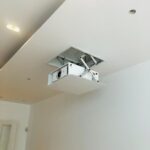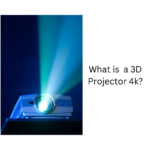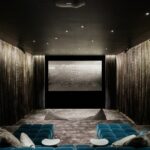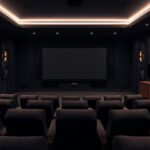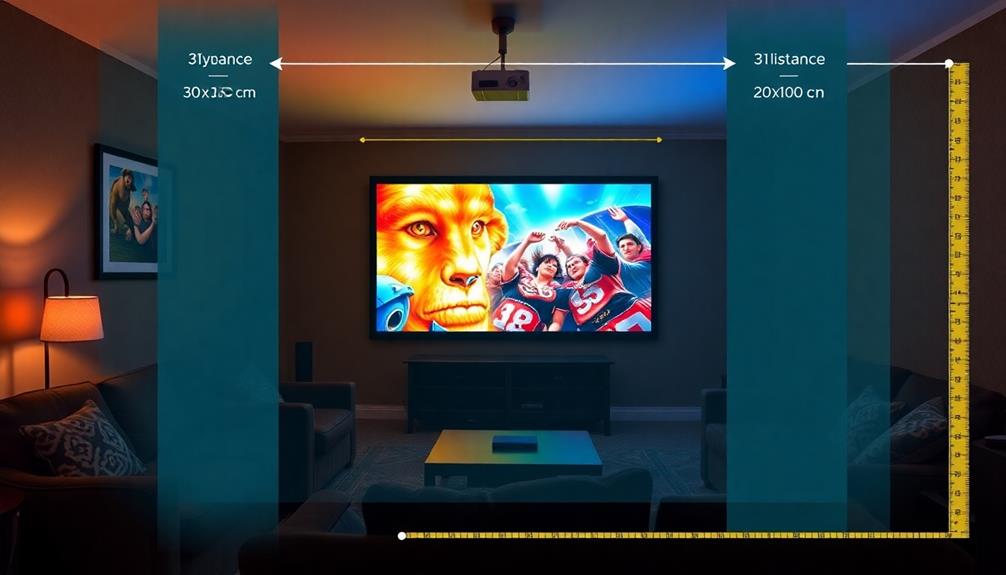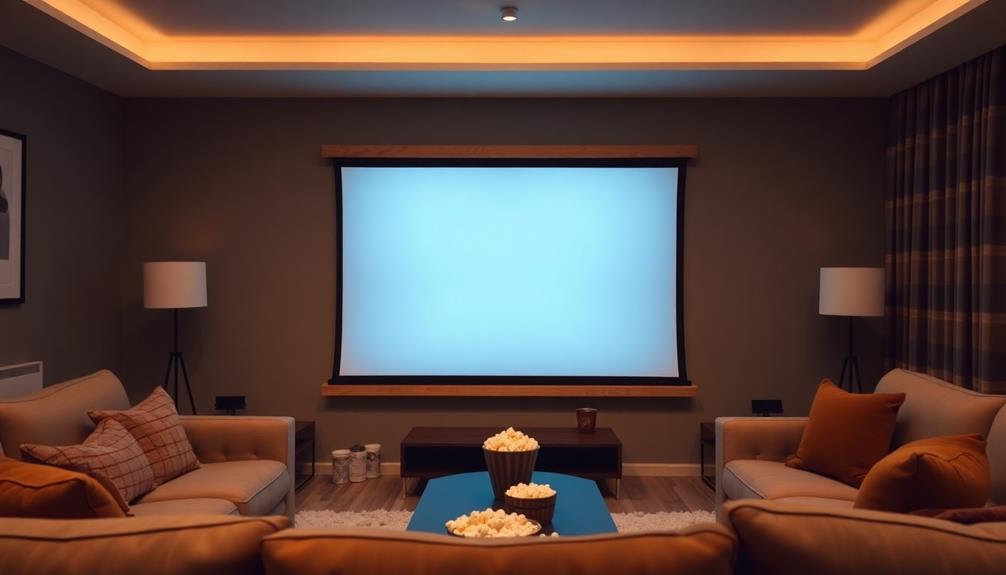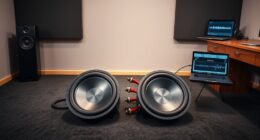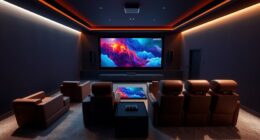Looking to take your movie nights to the next level? Look no further than home theater projectors! With their ability to create an immersive and cinematic experience, these devices have become a popular choice for movie enthusiasts and casual viewers alike. In this article, we will introduce you to the best home theater projectors on the market, from high-quality options to affordable choices, and the latest 4K and HD models. Get ready to transform your living room into a personal theater with our top-rated projector recommendations!
Key Takeaways:
- Home theater projectors offer an immersive viewing experience for a cinematic feel at home.
- Consider factors like image resolution, brightness, contrast ratio, throw distance, and connectivity options when choosing a projector.
- The Epson Pro Cinema LS12000 is our top pick for the best overall home theater projector.
- The BenQ TK700STi is the best budget-friendly home theater projector option.
- The JVC DLA-NZ8 is the best premium home theater projector choice for perfectionists.
The Benefits of Home Theater Projectors
Home theater projectors offer several advantages over traditional televisions. They provide an immersive viewing experience, allowing you to feel like you’re in a movie theater. With a larger screen size, home theater projectors create a more cinematic and realistic feel. They also offer flexibility in terms of positioning, as they don’t take up much room and can be easily mounted on a wall or ceiling. Additionally, projectors can be used both indoors and outdoors, making them perfect for movie nights under the stars.
Projectors have the ability to transform movie nights into unforgettable experiences. Whether you’re watching the latest blockbuster or your favorite classic film, the large and immersive image projected by a home theater projector makes every detail come to life. From vibrant colors to sharp details, the cinematic magic of a projector enhances your viewing experience and captures the true essence of the filmmaker’s vision.
“Home theater projectors transport you to a world of cinematic magic, where you can immerse yourself in the story and escape from reality. The larger screen size and stunning visuals created by projectors create an unparalleled experience that simply can’t be replicated by a traditional TV. Transforming your living room into a private movie theater, projectors allow you to enjoy films the way they were meant to be seen – with breathtaking visuals and immersive sound.”
Enhancing Every Movie Night
Whether you’re a film enthusiast or simply enjoy a cozy night in with your favorite movies, home theater projectors offer a unique way to elevate your entertainment experience. With their ability to provide an immersive viewing experience and transport you to a world of cinematic magic, projectors have become a popular choice for movie lovers.
So, if you’re ready to transform your movie nights and create a truly immersive viewing experience, consider investing in a home theater projector. With their larger screen size, realistic visuals, and flexibility in positioning, projectors bring the magic of the cinema to the comfort of your own home.
| Traditional TVs | Home Theater Projectors | |
|---|---|---|
| Screen Size | Limited to the size of the TV | Can project a larger image for a more immersive experience |
| Positioning | Takes up space, limited to a specific location | Can be easily mounted on a wall or ceiling, freeing up space |
| Indoor/Outdoor Use | Primarily for indoor use | Can be used both indoors and outdoors, perfect for movie nights under the stars |
Factors to Consider When Choosing a Home Theater Projector
When it comes to choosing a home theater projector, there are several important factors that you should consider. These factors will help ensure that you select the right projector for your needs, providing you with the best possible viewing experience. Here are the key factors to keep in mind:
1. Image Resolution
The image resolution of a projector determines the level of detail and clarity in the visuals. Higher resolution options, such as 4K or HD, will provide sharper and more detailed images. Consider the resolution that best suits your preferences and the content you plan to watch on your home theater system.
2. Brightness and Contrast Ratio
The brightness and contrast ratio of a projector significantly impact the quality of the image. Higher brightness ensures that the picture remains clear and vibrant, even in well-lit rooms. A higher contrast ratio, on the other hand, enables deeper blacks and more vivid colors, enhancing the overall visual experience. Look for projectors with good brightness and contrast performance.
3. Throw Distance
The throw distance refers to the distance between the projector and the screen or wall on which the image is projected. It determines the size and aspect ratio of the projected image. Consider the size of your room and the desired screen size to choose a projector with an appropriate throw distance for your space.
4. Connectivity Options
Consider the connectivity options offered by the projector, such as HDMI ports and wireless capabilities. These features allow you to connect your projector to various devices, such as Blu-ray players, gaming consoles, and streaming devices. Ensure that the projector has the necessary connectivity options to seamlessly integrate with your home theater setup.
| Factors to Consider When Choosing a Home Theater Projector |
|---|
| Image Resolution |
| Brightness and Contrast Ratio |
| Throw Distance |
| Connectivity Options |
Choosing the right home theater projector involves considering these key factors to ensure that you make an informed decision. Take the time to research and compare different projectors based on these factors to find the perfect one for your home theater setup.
Best Overall Home Theater Projector: Epson Pro Cinema LS12000
When it comes to the best overall home theater projector, the Epson Pro Cinema LS12000 takes the top spot. This laser-based 3LCD model offers a combination of exceptional features and performance that will enhance your viewing experience. With its good brightness and excellent contrast, the LS12000 delivers a stunning image quality that rivals traditional movie theaters. Whether you’re watching movies, TV shows, or playing games, this projector will immerse you in a world of vibrant colors and sharp details.
The Epson Pro Cinema LS12000 is designed to provide an extraordinary cinematic experience with its advanced technology and precise image reproduction. It offers a wide color gamut and deep black levels, resulting in a picture that is both accurate and visually stunning. The projector also features high dynamic range (HDR) support, further enhancing the contrast and color accuracy of the content you’re watching.
With its versatile connectivity options, the LS12000 allows you to easily connect your favorite devices, such as Blu-ray players, gaming consoles, and streaming devices. It also offers flexible installation options, thanks to its motorized lens shift, zoom, and focus capabilities. Whether you have a dedicated home theater room or a multipurpose living space, the LS12000 can adapt to your needs.

Key Features of the Epson Pro Cinema LS12000:
- Native resolution: up to 4K
- Laser light source with a long lifespan
- High brightness for vibrant visuals
- Excellent contrast ratio for deep blacks
- Wide color gamut for accurate color reproduction
- Motorized lens shift, zoom, and focus
- Flexible connectivity options
With its impressive features and performance, the Epson Pro Cinema LS12000 is the best overall home theater projector that will truly elevate your viewing experience.
Best Budget Home Theater Projector: BenQ TK700STi
When it comes to finding a budget-friendly home theater projector that doesn’t compromise on quality, the BenQ TK700STi is the perfect choice. This low-cost DLP model offers better than average brightness and a low input lag, ensuring a delightful viewing experience without breaking the bank.
The BenQ TK700STi may not have all the fancy features of higher-end projectors, but it truly shines in terms of performance. With its impressive brightness level, you can enjoy vibrant and vivid visuals that bring your movies and shows to life. The low input lag means that you won’t experience any noticeable delays between your inputs and the projector’s response, making it ideal for both casual viewing and fast-paced gaming sessions.
Whether you’re setting up a home theater system on a budget or simply looking for an affordable projector for occasional use, the BenQ TK700STi delivers exceptional value for your money. Its combination of affordability, better than average brightness, and low input lag make it a top choice for anyone seeking a budget-friendly home theater projector.

Key Features of the BenQ TK700STi:
- Low-cost DLP model
- Better than average brightness
- Low input lag
Specifications:
| Resolution | Brightness | Contrast Ratio | Throw Distance | Connectivity Options |
|---|---|---|---|---|
| 1080p (Full HD) | 3,200 lumens | 10,000:1 | 1.37 – 1.64 | HDMI, USB, VGA |
Best Premium Home Theater Projector: JVC DLA-NZ8
If you’re a home theater perfectionist looking for the ultimate viewing experience, the JVC DLA-NZ8 is the best premium choice. This native 4K projector offers superior HDR performance, delivering stunning picture quality with incredible detail and color accuracy. The DLA-NZ8 is designed to bring the cinema to your home, providing a true cinematic experience that will impress even the most discerning viewers.
“The JVC DLA-NZ8 is a game-changer. The native 4K resolution and superior HDR performance make every movie feel like a masterpiece. The colors are rich and vibrant, and the black levels are deep and inky. It’s the closest you can get to a true cinema experience in your own home.” – Home Theater Enthusiast
Featuring JVC’s cutting-edge technology, the DLA-NZ8 offers industry-leading image quality and performance. Its dynamic HDR processing enhances the contrast and color accuracy, bringing out the details in both bright and dark scenes. The projector’s high brightness ensures a vivid and vibrant picture, even in well-lit rooms. With its exceptional black levels, the DLA-NZ8 provides a true cinematic experience, immersing you in the world of your favorite movies.
With its sleek and stylish design, the JVC DLA-NZ8 will complement any home theater setup. It offers a range of connectivity options, including multiple HDMI ports and wireless capabilities, making it easy to integrate with your existing devices. Whether you’re watching movies, gaming, or enjoying your favorite TV shows, the DLA-NZ8 delivers an unparalleled viewing experience that is sure to impress.

| Features | Specifications |
|---|---|
| Resolution | Native 4K |
| HDR | Dynamic HDR processing |
| Brightness | High brightness for vivid images |
| Contrast | Exceptional black levels |
| Connectivity | Multiple HDMI ports, wireless capabilities |
Best 4K Home Theater Projector for Sports: Epson EpiQVision Ultra LS800
Impressive Brightness for an Immersive Sports Viewing Experience
When it comes to watching sports on a home theater projector, brightness is a crucial factor. The Epson EpiQVision Ultra LS800 excels in this aspect, offering an impressive 4,000 lumens brightness. This ensures that even in well-lit rooms, you’ll be able to enjoy a bright and vibrant image, allowing you to catch every detail of the action. Whether it’s a fast-paced football match or an intense basketball game, the LS800 delivers a visually stunning experience that makes you feel like you’re right there in the stadium.
Enhanced Audio with a Yamaha-Designed Built-in Speaker System
While visuals are important, immersive sound is equally crucial when it comes to sports viewing. The Epson LS800 doesn’t disappoint in this department either. It features a Yamaha-designed built-in speaker system that delivers exceptional audio quality. This creates a strong virtual surround sound effect, enhancing the overall viewing experience. From the roar of the crowd to the crisp sound of the ball hitting the net, the LS800 ensures that you don’t miss a beat when watching your favorite sports events.
Summary of the Epson EpiQVision Ultra LS800
In summary, the Epson EpiQVision Ultra LS800 is the best 4K home theater projector for sports enthusiasts. With its impressive 4,000 lumens brightness and Yamaha-designed built-in speaker system, it offers a truly immersive viewing experience. Whether you’re watching a live game or catching up on highlights, the LS800 delivers stunning visuals and enhanced audio that will make you feel like you’re at the heart of the action.
| Key Features | Specifications |
|---|---|
| Brightness | 4,000 lumens |
| Resolution | 4K |
| Contrast Ratio | Up to 1,000,000:1 |
| Speaker System | Yamaha-designed built-in speakers |
| Connectivity | HDMI, USB, Ethernet |
| Throw Distance | Short to long throw |
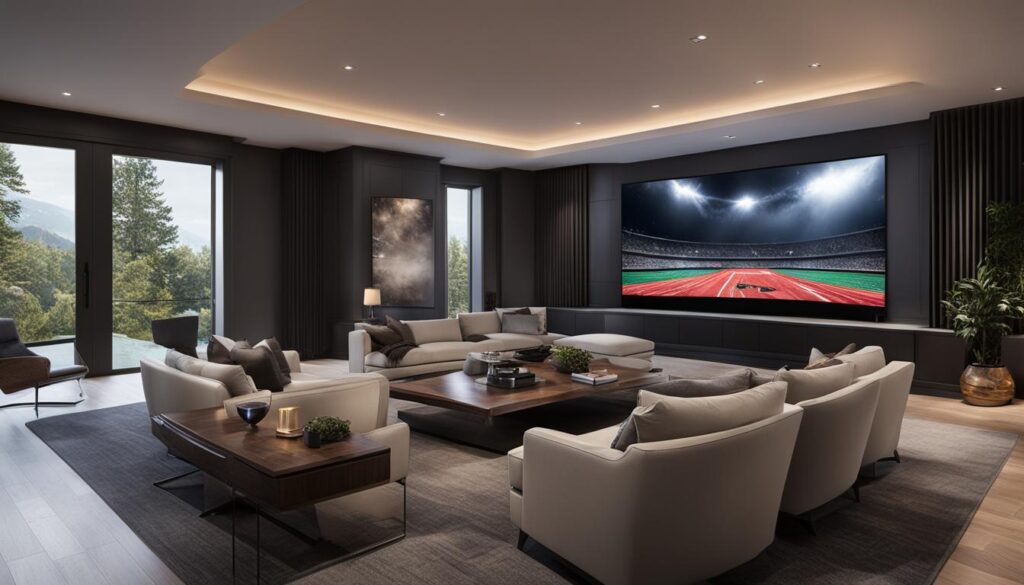
Best Portable Home Theater Projector: Samsung The Freestyle
If you’re looking for a portable home theater projector that combines convenience, versatility, and stunning visuals, then the Samsung The Freestyle is the perfect choice. This HD projector offers a sleek design and packs a punch with its built-in streaming capabilities, 360-degree sound, and voice assistant support. Whether you’re on the go or enjoying a movie night at home, the Samsung The Freestyle provides an immersive viewing experience that can rival traditional home theaters.
With its HD resolution, the Samsung The Freestyle delivers sharp and vibrant images, bringing your favorite movies and shows to life. The built-in streaming capabilities allow you to access popular streaming platforms directly from the projector, eliminating the need for additional devices. And with its 360-degree sound technology, you’ll enjoy a truly immersive audio experience that fills the room.
Whether you’re traveling, camping, or simply want to enjoy a movie night in your backyard, the portability of the Samsung The Freestyle makes it a breeze to set up and enjoy your favorite content wherever you are. Its compact size and lightweight design make it easy to carry, while its versatile connectivity options ensure seamless integration with your other devices.
Key Features of the Samsung The Freestyle:
- HD resolution for sharp and detailed visuals
- Built-in streaming capabilities for easy access to your favorite content
- 360-degree sound technology for an immersive audio experience
- Voice assistant support for convenient control
- Portable and lightweight design for on-the-go entertainment
With the Samsung The Freestyle, you can enjoy the freedom of a portable home theater projector without compromising on quality. Whether you’re watching movies, streaming shows, or playing games, this projector provides a captivating and immersive viewing experience that will enhance your entertainment wherever you are.

Best Ultra Short Throw Home Theater Projector: Hisense L9G TriChroma Laser 4K TV
If you’re looking for the best ultra short throw home theater projector, look no further than the Hisense L9G TriChroma Laser 4K TV. This ultra short throw model is designed to be placed just inches away from the wall or screen, delivering a large, immersive viewing experience without the need for a long throw distance.
One of the standout features of the Hisense L9G is its high brightness, which ensures that your projected image remains vibrant and clear even in well-lit environments. With its laser technology, this projector produces bright and vivid colors, bringing your favorite movies, TV shows, and games to life.
In addition to its impressive brightness, the Hisense L9G TriChroma Laser 4K TV offers rich color reproduction, allowing you to enjoy true-to-life visuals. Whether you’re watching a thrilling action movie or a stunning nature documentary, every detail will be enhanced with striking clarity and depth.
With the Hisense L9G TriChroma Laser 4K TV, you no longer have to compromise on image quality or throw distance. This projector combines the convenience of an ultra short throw with the exceptional performance of a high-quality 4K TV, providing you with a complete home theater solution in one compact package.
| Features | Description |
|---|---|
| Ultra Short Throw | This projector can be placed just inches away from the wall or screen, saving space and offering flexibility in positioning. |
| High Brightness | The Hisense L9G delivers impressive brightness, ensuring clear and vibrant images even in well-lit environments. |
| Rich Color Reproduction | Experience true-to-life visuals with the projector’s rich color reproduction, bringing your favorite content to life with stunning clarity and depth. |
| 4K Resolution | Enjoy a sharp and detailed image with the 4K resolution, allowing you to see every detail of your favorite movies, TV shows, and games. |
| Laser Technology | The laser technology used in the Hisense L9G ensures a long-lasting and reliable performance, delivering consistent image quality over time. |

Conclusion
When it comes to ultra short throw home theater projectors, the Hisense L9G TriChroma Laser 4K TV stands out as the best option. With its ultra short throw capability, high brightness, rich color reproduction, and 4K resolution, it offers an immersive and visually stunning viewing experience. Whether you’re watching movies, TV shows, or playing games, the Hisense L9G delivers exceptional performance and convenience in a single package.
How to Choose a Home Theater Projector
When it comes to selecting the perfect home theater projector, considering a few key factors can make the decision-making process easier. We’ve compiled a list of essential elements to keep in mind, ensuring you find a projector that meets your specific needs and preferences.
Image Resolution
One of the first things to consider is the image resolution. Higher resolution projectors, such as those offering 4K or HD, will provide a sharper and more detailed picture. If you’re looking for a truly immersive viewing experience, opting for a higher resolution projector is recommended.
Brightness and Contrast Ratio
Brightness and contrast ratio are crucial for vibrancy and depth of colors in your projected image. A projector with high brightness ensures that the picture is still clear and vivid, even in well-lit environments. Similarly, a high contrast ratio enhances the distinction between bright and dark areas, resulting in more realistic visuals.
Throw Distance and Screen Size
The throw distance refers to the distance between the projector and the screen, which determines the size of the projected image. Consider the available space in your home theater setup and choose a projector with a throw distance that suits your needs. Additionally, ensure that the projector’s throw ratio matches the desired screen size.
Connectivity Options
Lastly, it’s essential to consider the connectivity options offered by the projector. Check for HDMI ports and wireless capabilities to ensure seamless integration with other devices, such as Blu-ray players and streaming devices. This will allow you to enjoy your favorite content with ease.
| Factor to Consider | Key Points |
|---|---|
| Image Resolution | Opt for higher resolution projectors like 4K or HD for sharper and more detailed visuals. |
| Brightness and Contrast Ratio | Choose a projector with high brightness and a high contrast ratio for vibrant colors and rich blacks. |
| Throw Distance and Screen Size | Consider the available space and choose a projector with a suitable throw distance for your desired screen size. |
| Connectivity Options | Ensure the projector has HDMI ports and wireless capabilities for seamless integration with other devices. |
By taking these factors into account, you can make an informed decision and find the perfect home theater projector that will provide a truly immersive and cinematic viewing experience.
How We Test Home Theater Projectors
At our testing facility, we have a meticulous and thorough process for evaluating home theater projectors. Our goal is to provide accurate and helpful reviews that assist our readers in making informed purchasing decisions. Our team is passionate about finding the best projectors on the market and ensuring they meet the highest standards of image quality, performance, and user experience.
When testing home theater projectors, we pay close attention to the image quality they deliver. We analyze factors such as color accuracy, contrast ratio, brightness, and overall clarity to determine how well a projector reproduces the intended image. We test projectors in various lighting conditions and viewing scenarios to ensure their performance in real-world situations.
In addition to image quality, we also evaluate the performance of home theater projectors. This includes assessing factors such as input lag, response time, motion handling, and image processing capabilities. We want to ensure that the projectors we recommend can handle fast-paced action scenes, gaming, and other demanding content with ease.
Lastly, we take into account the user experience of each projector. We consider factors such as ease of setup, menu navigation, remote control functionality, and connectivity options. We want to ensure that the projectors we recommend are user-friendly and integrate well with other devices, providing a seamless and enjoyable home theater experience.

Conclusion
In conclusion, home theater projectors bring the magic of the cinema to the comfort of your own home. Whether you’re a movie buff, a sports enthusiast, or simply enjoy immersive entertainment, there is a projector that will suit your needs and enhance your viewing experience.
After extensive research and testing, we have identified the top recommendations in different categories. For the best overall performance, we recommend the Epson Pro Cinema LS12000. This projector offers excellent image quality, good brightness, and a reasonable price point. It is a versatile option that will elevate your movie nights and TV watching.
If you’re on a budget, the BenQ TK700STi is the best choice. With better than average brightness and a low input lag, this projector delivers a solid performance at an affordable price. It is perfect for both gaming and traditional home theater use.
For those seeking the ultimate home theater experience, we recommend the JVC DLA-NZ8. This premium projector offers native 4K resolution, superior HDR performance, and exceptional picture quality. It is the ideal choice for home theater perfectionists who want to reproduce true cinema-quality visuals.
Explore these top home theater projectors and take your viewing experience to the next level. Whether you’re watching movies, sports, or your favorite TV shows, these projectors will transform your living room into a private home theater.
FAQ
What are the benefits of home theater projectors?
Home theater projectors provide an immersive viewing experience, bringing the cinematic magic to your home. They also offer a larger screen size for a more realistic feel and flexibility in positioning. Additionally, projectors can be used indoors and outdoors, making them perfect for movie nights under the stars.
What factors should I consider when choosing a home theater projector?
When choosing a home theater projector, consider the image resolution, brightness, contrast ratio, throw distance, and connectivity options. These factors will ensure crisp visuals, vibrant colors, the right image size, and seamless integration with other devices.
What is the best overall home theater projector?
The Epson Pro Cinema LS12000 is our top pick for the best overall home theater projector. It offers a great all-around viewing experience with good brightness and excellent contrast.
What is the best budget home theater projector?
The BenQ TK700STi is the best choice for a budget-friendly home theater projector. It offers better than average brightness and a low input lag at an affordable price point.
What is the best premium home theater projector?
The JVC DLA-NZ8 is the best premium home theater projector. It offers superior picture quality and performance, making it a top choice for home theater perfectionists.
What is the best 4K home theater projector for sports?
The Epson EpiQVision Ultra LS800 is the best 4K home theater projector for sports. It delivers bright and vibrant images and features a Yamaha-designed built-in speaker system for an immersive sports viewing experience.
What is the best portable home theater projector?
The Samsung The Freestyle is the best choice for a portable home theater projector. It offers a sleek design, built-in streaming capabilities, and 360-degree sound for easy and convenient use.
What is the best ultra short throw home theater projector?
The Hisense L9G TriChroma Laser 4K TV is the best ultra short throw home theater projector. It can project big images from inches away and offers high brightness and rich color.
How do I choose a home theater projector?
To choose a home theater projector, consider the image resolution, brightness, contrast ratio, throw distance, and connectivity options. These factors will ensure a sharp and detailed picture, vibrant colors, the right image size, and seamless integration with other devices.
How do you test home theater projectors?
At our testing facility, we evaluate home theater projectors by assessing image quality, performance, and user experience. We test the projectors in various lighting conditions and viewing scenarios to ensure their real-world performance. We also take into account feedback from readers and consider industry experts’ opinions.
Source Links
- https://www.techradar.com/best/4k-projector
- https://www.cbsnews.com/essentials/best-home-projectors-create-a-cinematic-viewing-experience-in-your-tv-room/
- https://www.popsci.com/reviews/best-home-theater-projectors/
Carl is the author of 1home Theatre Projector. When he’s not busy writing about all things projector-related, you can find him playing basketball or watching a good movie. He knows that jumping to a projector-based home cinema can be daunting, but he’s here to help make it as easy as possible. With his comprehensive guides and product reviews, you’ll be able to find the right projector for your needs and set it up in no time. Plus, he’s always on top of the latest news and information on upcoming releases, so you’ll always be ahead of the curve.



